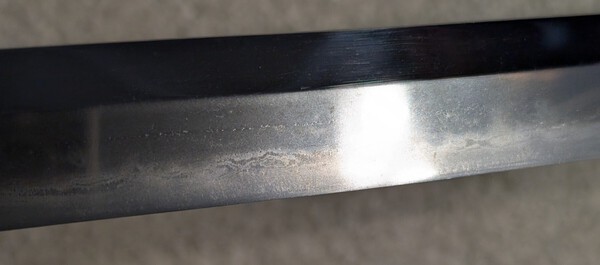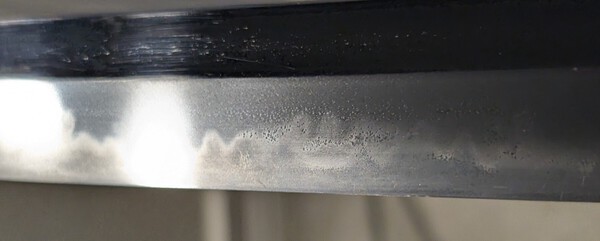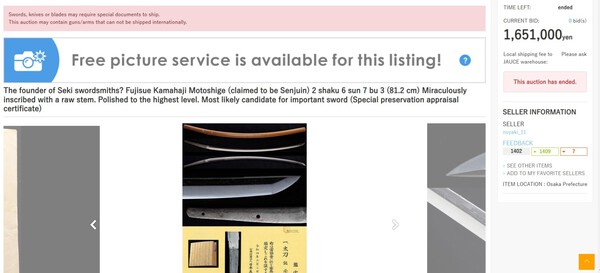
Gerry
-
Posts
177 -
Joined
-
Last visited
Content Type
Profiles
Forums
Events
Store
Downloads
Gallery
Posts posted by Gerry
-
-
-
-
Aoi Art actually had a reasonably priced Morioka Miyaguchi daisho (900,000 yen) that I was almost going to buy back in Nov last year. I went down to the store, viewed the blades, and spoke to Tsurata-san about getting the daisho certified as such with NBTHK papers. He confirmed that as long as a katana and wakizashi were of the same smith with matching mei and nenki, NBTHK would paper them together on the same certificate.
I went ahead and reserved the daisho, and was preparing payment when Aoi realized that Mr. Miyaguchi was still alive at 92 years old, and was still taking commissions for swords! So I couldn't get the daisho papered, and didn't proceed with the purchase.
Therefore, it's apparently reasonably easy to get daisho NBTHK papers if you meet the conditions stated above, but you don't really see pre-shinshinto blades made as daisho.
-
 1
1
-
-
It's odd that another soshou mei Shigetsugu on Aoi Art's website sold for much less in 2022, with a nicer hamon and papers too.
https://sword-auction.com/en/product/10012/as21733-刀:笠間一貫斎繁継作/
I guess the winning bidder in today's auction really wanted the sword.
-
Ah, my apologies...from the numerous comments I've seen on this forum, I've always assumed that pretty much all the serious collectors here abhor "Fleabay", but I guess not.
And is there really any chance of quietly bidding on anything on eBay nowadays, ha ha.
-
 1
1
-
 1
1
-
-
-
There's a listing for a soshou-mei Shigetsugu made in 1937 at the moment, and it's the first one I've seen with a mostly suguha hamon:
https://www.ebay.com/itm/396194115902
Let's see how much it will eventually go for, despite the seller having no idea of the mei and nenki.
-
 1
1
-
-
Samurai shokai actually has 2 gendaito kogarasu marus for sale if you're considering modern pieces.
-
I'm in the same mind of thought as you...as with anything to do with art, the item has to elicit an emotional pull. All the swords I've purchased have had to excite me on an emotional level above anything else, so that I get a sense of enjoyment whenever I hold the sword.
-
 2
2
-
-
This topic also brings up another question I have.
With the hobby of appreciating nihonto, how much of the value and perceived quality of a blade is due to subjective vs objective reasons?
For example, with my limited knowledge, objectively, collectors look at the tightness and color of the jigane, the activity in the hamon, the physical balance of the blade, no kizu/ware, etc.
However, there are subjective aspects also, such as the sori, the pattern of the jigane, the overall shape of the blade, the hamon style, etc.
Do seasoned collectors generally agree on the combination of subjective and objective aspects of a blade to determine its value? Or do they have quite varying degrees of preference? I guess that's where the papers come in, to give a consistency in the appraisal of a blade.
-
Thanks for all the insightful replies, and once again, the breadth of knowledge on this forum is amazing.
-
17 hours ago, Hoshi said:
Thanks for sharing. this is certainly useful read.
-
I've seen quite a few Tokubetsu Hozon blades that have prices that surpass those of Juyo blades, but I rarely see Hozon blades over 1M yen.
An example is this 2.4M yen Hozon Kanesada katana is priced so high because of the smith: https://www.tsurugin...om/items/a00642.html
Has anyone else seen examples of Hozon blades over 1M yen or more?
-
Sorry to hear about your bad experience with Jauce. I've purchased 26 swords through them in the last 10 months, and haven't had any issues with the export permits applications. There's one sword that had a wrong torokusho that had to be re-issued, but Jauce was very clear with updates through the whole process, which took about 5 months.
Maybe you can email their customer service people to check if your sword had a torokusho issue, and ask for details? They even told me which month the education board was meeting to rview and re-issue my torokusho, and when the new torokusho arrived.
-
This kogarasu maru went for quite a princely sum.
https://www.jauce.com/auction/u1170168654
The nakago has quite a pronounced funbari, but the hamon looked too odd to me to want to place a bid.
And it's weird that the nakago also looks suriage. Why would anyone need to suriage a kogarasumaru? They're usually not long to begin with.
-
 1
1
-
-
Here's an interesting set of mounts on this shungunto: https://www.jauce.com/auction/w1170939001
-
 1
1
-
-
Some of the junior licensed swords smiths in Japan make blades to fit antique koshirae. You can find them online and contact them. However, you'll need to send at least the tsunagi in to them, if not the entire koshirae to be safe, and the blade will probably cost you $7K USD or so.
-
Hi Jussi,
Thanks for sharing these links to swords with early nengo inscriptions, so there's still hope if I keep my eyes peeled at the usual suspect of Japanese dealer sites.
-
On 1/4/2025 at 10:03 AM, Mark S. said:
Please excuse if this has been asked/answered before. Wasn’t sure what term to use in search function. Found this example on line and have seen it before. There is a distinct line on the nakago of this suriage blade. Was it a ‘guide’ for the person shortening the blade or was it placed to determine ‘old’ from ‘new’? Very obviously on this blade, it differentiates the where the file marks change. Not all suriage blades have this mark. Finally, does this line have a ‘name’? Any discussion or thoughts on this are invited. Interesting also is that (to me) the upper mekugi-ana seem older than the lower one, which you would think would be opposite.
It's where the original nakago line ended before the sword underwent machi okuri/suriage.
-
Wow, that's much older than I had imagined, but these 2 examples are probably not something that a run of the mill collector like me would be able to afford, ha ha.
-
I've been looking around for while to see if I could get a papered katana with an early nengo inscription on the nakago, and the earliest ones I have seen are from the mid-1400s.
Has anyone seen nengo from an earlier date, like in the 1300s?
-
https://www.jauce.com/auction/w1165674644
It'll be interesting to see how much this one eventually goes for.
-
It's pretty crazy that a seller would think that someone would pay 5.5M yen for something through an online auction. But hey, the Yen's back down again at 157 to 1 USD today, so you never know!
-
Seems like signed, ubu, long, koto tachis are still rare and desirable. The 1.65M yen final bid didn't make the reserve price.
https://www.jauce.com/auction/s1165164742













Unique looking habaki photos to share
in Tosogu
Posted
I've always seen that good blades are usually accompanied with nice habaki, and not usually the other way around, so I put good value in nice custom habaki. Most of my swords have the standard cat-scratch textured habaki, but I thought I'd share a few with more unique designs.
I particularly like this one with the dragon detail.
And this one on the left is just a massive regular habaki, compared to a similar one next to it on a 26.5" kai gunto.